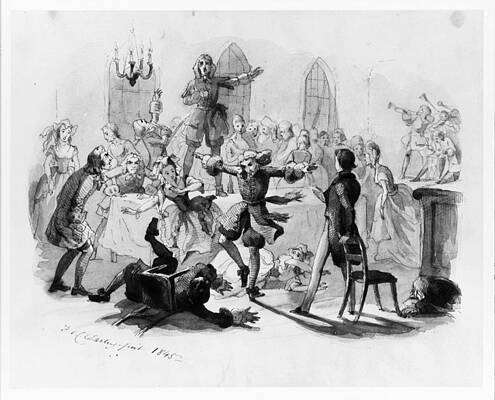Felix Octavius Carr Darley
A Rowdy Party


Battle scene with charging cavalry and artillery

Battle scene with line of bayonets




Calvary officer from rear, mounted cavalry officer receiving message



Farmer with scythe walking down road after livestock

Goat in bedroom gazing at sleeping person







Male figure laid over a barrel with crowd looking on

Man by chair addressing meeting

Man fallen or pushed into wheel barrow



Man sitting on wheelbarrow looking at frog



Revolutionary War battle between civilians and British soldiers

Revolutionary War battle scene

Scene from the life of Washington

Schuylhill, Fairmont Water Works, Philadelphia



The boys that run with the engine





Two women standing over seated reading woman

Walking hunter with two hounds

War of 1812 battle scene with soldiers and Indians
Felix Octavius Carr "F. O. C." Darley (June 23, 1822 – March 27, 1888) was an American painter in watercolor and illustrator, known for his illustrations in works by well-known 19th-century authors, including James Fenimore Cooper, Charles Dickens, Mary Mapes Dodge, Nathaniel Hawthorne, Washington Irving, George Lippard, Henry Wadsworth Longfellow, Donald Grant Mitchell, Clement Clarke Moore, Frances Parkman, Harriet Beecher Stowe and Nathaniel Parker Willis.[1]
Life and work
Mrs. F.O.C. Darley
Darley was born on June 23, 1822, in Philadelphia, Pennsylvania.[2] He was a self-taught and prolific artist who started out as a staff artist for a Philadelphia publishing company where he was given a wide variety of assignments.
After he moved to New York, his work began to appear in magazines such as Harper's Weekly and in books by various publishers. Darley made 500 drawings for Lossing's History of the United States. Among his lithographic illustrations are those for Irving's "The Legend of Sleepy Hollow", and some scenes in Indian life. The swing and vigor of his style, his facility, and versatility and the high average merit of his numerous works, make him one of the most noteworthy of American illustrators.
Grave of F. O. C. Darley at Mount Auburn Cemetery in Cambridge, Massachusetts
Darley signed a contract with Edgar Allan Poe on January 31, 1843, to create original illustrations for his upcoming literary journal The Stylus.[3] The contract, which was through July 1, 1844, requested at least three illustrations per month, "on wood or paper as required," but no more than five, for $7 per illustration.[4] The Stylus was never actually produced but Darley provided illustrations for the final installments of the first serial publication of Poe's award-winning tale "The Gold-Bug" later that year.[5]
In 1848, Darley provided the drawings for the first fully illustrated edition of Irving's "Rip Van Winkle",[6] which was printed and distributed by the American Art-Union.[7] That same year, Darley also illustrated an edition of Irving's The Sketch Book of Geoffrey Crayon, Gent. and then his Wolfert's Roost in 1855.[7] Over his career, he produced nearly 350 drawings for James Fenimore Cooper, later collected in a several-volume edition of Cooper's novels printed from 1859 to 1861.[7] In 1868 he published, after a visit to Europe, Sketches Abroad with Pen and Pencil. His water color paintings of incidents in American history are full of spirit and his bank-note vignettes are also worthy of mention. In 1851, he was elected into the National Academy of Design as an Honorary member, and became a full Academician in 1852.
John Neal Hoover has written a scholarly article on Darley with a section on further reading.[8]
Darley died in 1888 at his home in Claymont, Delaware, and is buried at Mount Auburn Cemetery in Cambridge, Massachusetts. His Victorian mansion, located in Claymont, is now known as the Darley House and was placed on the National Register of Historic Places in 1974.
References
Notes
Pitz, Henry C. (1968). The Brandywine Tradition. Weathervane Books. p. 31. ISBN 0-517-16431-0.
Pitz, Henry C. (1968). The Brandywine Tradition. Weathervane Books. p. 22. ISBN 0-517-16431-0.
Allen, Hervey. Israfel: The Life and Times of Edgar Allan Poe. New York: Farrar & Rinehart, Inc., 1934: 224.
F. O. C. Darley Society online
Quinn, Arthur Hobson. Edgar Allan Poe: A Critical Biography. Baltimore: Johns Hopkins University Press, 1998: 338. ISBN 0-8018-5730-9.
Burstein, Andrew. The Original Knickerbocker: The Life of Washington Irving. New York: Basic Books, 2007: 337. ISBN 978-0-465-00853-7
Callow, James T. Kindred Spirits: Knickerbocker Writers and American Artists, 1807–1855. Chapel Hill: The University of North Carolina Press, 1967: 184.
Hoover, John Neal. Felix Darley, in The Private Library Autumn 1994, published by the Private Libraries Association
Attribution
This article incorporates text from a publication now in the public domain: Gilman, D. C.; Thurston, H. T.; Colby, F. M., eds. (1905). "F. O. C. Darley". New International Encyclopedia (1st ed.). New York: Dodd, Mead.
----
Fine Art Prints | Greeting Cards | Phone Cases | Lifestyle | Face Masks | Men's , Women' Apparel | Home Decor | jigsaw puzzles | Notebooks | Tapestries | ...
----
Artist
A - B - C - D - E - F - G - H - I - J - K - L - M -
N - O - P - Q - R - S - T - U - V - W - X - Y - Z
Retrieved from "http://en.wikipedia.org/"
All text is available under the terms of the GNU Free Documentation License



